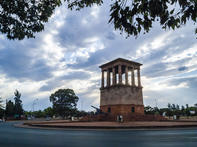The Siege of Kimberley
The Siege of Kimberley (15 October 1899 - 15 February 1900) acts as an endpoint for the fascinating N12 Battlefield Route, which takes in the battle of Belmont (23 November 1899), Graspan (25 November 1899), Modder River (28 November 1899) and Magersfontein (11 December 1899).

Magersfontein Trap
On 11 December 1899, Boer troops led by General Piet Cronjé delivered a devastating defeat on a British column of Highland battalions led by General Wauchope and commanded by Lord Methuen, marching with confidence northwards along the old railway line towards Kimberley over the flat, arid and intensely hot Karoo.
We can only imagine what the Highland troops, who took the brunt of the withering Boer fire, must have felt like in their heavy kilts and full gear, having come straight from the northern winter.
As they began their midnight advance, they were lashed by a violent thunderstorm. The Boers were dug into a line of trenches on the flat ground just a few hundred metres in front of the Magersfontein hills, and the advancing British soldiers never saw anything until the barrage of Boer rifle fire began to cut them to ribbons at what, for the Boers, was close range.
A survivor said the Boer fire was so persistent it sounded like fat frying in a very hot pan. Earlier, at Belmont, Graspan and Modder River, the Boers had allowed Methuen's men to rout them in the hills and koppies.
The British troops, not expecting the Boers to be in the lowlands, marched right into the Magersfontein trap, expertly set by the Boer tactical fox, General Koos de la Rey. As you drive along the N12 about 36 km south of Kimberley in the Northern Cape, it's chilling to think about what happened more than 100 years ago, right beside where the road is now.
A 10-day Battle

After the success of Magersfontein, General Piet Cronjé (at that stage Supreme Commander) led his men to Paardeberg (in the Free State) to await the main northward thrust of the British under Lords Roberts and Kitchener.
The ensuing 10-day battle, on the Modder River just north of the Orange from 17 to 27 February 1900, was not only the largest and bloodiest single battle of the Second Anglo-Boer War, but it was also its turning point. General Cronjé eventually surrendered the main Boer force, thus allowing General De Wet to break out with his men and wagons, saving their lives and their remaining wealth.
In retrospect, there is little they could have done to halt, or even really delay, the march of the vast British force across the Highveld all the way to Pretoria. Generals De Wet and De la Rey did put up resistance on the way to Bloemfontein, but the military backbone of the Boers was effectively broken.
The battlefield is immense, but field museums consisting of a roofed display and dioramas can be seen at the railway station where overall Boer commander Cronjé had his laager. There is another at Oskoppies, where Kitchener had his camp.